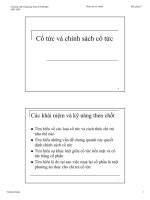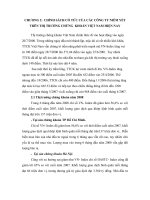DIVIDEND POLICY Chính sách cổ tức
Bạn đang xem bản rút gọn của tài liệu. Xem và tải ngay bản đầy đủ của tài liệu tại đây (114.92 KB, 9 trang )
A.
I.
1.
OVERVIEW OF DIVIDEND POLICY
DIVIDEND
Definition
A dividend is a distribution of a portion of a company's earnings, decided by
the board of directors, to a class of its shareholders. Dividends can be issued
as cash payments, as shares of stock, or other property.
Dividends include dividends for preferred shares and dividends for common
stock. Dividends paid to preferred shares is a level or a fixed rate under the
conditions applicable to each type of preferred shares. Dividends paid to
common stock is depended on the net income remaining after deduction of
profits retained for reinvestment and development of the business.
2.
a.
-
b.
-
Forms of payment
Payment of dividends in cash
The company annually pays dividends in the form of cash payments (cash
dividend, but may return many times in a year. When paying dividends,
cash items and retained earnings of the company are declined on the
balance sheet.
Dividend stocks
Payment of dividends in treasury shares: pay to existing shareholders by
shares, which were previously repurchased by businesses.
Payment by bonus stocks: is the issuance of additional shares to existing
shareholders.
Payment of dividends by splitting shares: essentially the same as payment
of dividend by stock at the rate of 1: 1
Pay dividends in shares are applied in case that company in the growth
retained profits for reinvestment.
c.
-
d.
-
Repurchase of shares
The company acquired its shares by buying or through open market =>
volume declines => higher stock price => It is possible to increase profit
per share.
Apply for companies have inactive money without investment plans
effectively.
Payment Dividend by other assets
Firms pay dividends to shareholders by paying the finished products,
goods, property or shares held by the company of the other companies.
-
This form is less common.
II.
1.
DIVIDEND POLICY
What is Dividend policy?
A dividend policy is a company's approach to distributing profits back to its
owners or stockholders.
Profit is retained as retained earnings or paid out to the stockholders as
dividend. Retained earnings will be reinvested and it gives them a source of
potential profit growth in the future, while dividends give them a current
income.
If a company does decide to pay dividends, it must then decide how often to
do so, and at what rate.
Dividend policy decide how profit is distributed. Therefore, it will affect the
proportion of equity in the capital structure (through retained earnings) and
the cost of capital for businesses.
2.
a.
Indicators of Dividend policy
Dividend Per Share (DPS)
DPS = Dividends paid/Number of shares (common stock)
The Dividend Per Share is defined as the dividends for each share of stock
issued.
Generally announced on a quarterly basis, the dividend per share is
important both to shareholders who expect to realize financial gain from
dividends paid and to financial analysts and investment brokers who often
use the dividend per share as an indicator of a company’s overall financial
profitability.
But this indicator doesn’t indicate thoroughly about dividend policy.
Because if based on it, investors just know how much money dividend they
receive, they don’t know the ratio of the dividends and retained earnings in
after-tax profits. So there is another indicator that can meet this requirement
– Dividend Payout Ratio.
b.
Dividend Payout Ratio (DPR)
DPR = Dividends/Net income
or
DPR=Dividends per share/Earnings per share
The Dividend Payout Ratio is the amount of dividends paid to stockholders
relative to the amount of total net income of a company. The amount that is
not paid out in dividends to stockholders is held by the company for growth.
The amount that is kept by the company is called Retained earnings.
The investors who want to have current income (for consuming…) will
demand high DPR. In contrast, the investors who don’t need income from
dividends at present and expect an increase in the value of shares in the
future will prefer companies have lower DPR and retain more profits for
reinvestment.
c.
Dividend Yield
Dividend Yield= Dividend per share/Price per share
The Dividend Yield shows how much a company pays out in each year
relative to its share price. It is the return on investment for a stock.
A company that is paying less in dividends relative to its price may be
having problems or it could be retaining more of a percentage of its net
income for growth
A lower (higher) dividend yield doesn’t imply lower(higher) dividends as
this rate also depends on the market price of shares. Therefore, this indicator
is used to compare the dividend policies of different companies having
similar characteristics in terms of business, size and price of shares.
3.
Types of Dividend policy
Dividend policy depends upon the nature of the firm, type of shareholder and
profitable position. On the basis of the dividend declaration by the firm, the
dividend policy may be classified under the following types:
Regular dividend policy
Stable dividend policy
Irregular dividend policy
No dividend policy.
a. Regular dividend policy
Dividend payable at the usual rate is called as regular dividend policy.
This type of policy is suitable to the small investors, retired persons and
others who want to get regular income.
This type of dividend payment can be maintained only if the company has
regular earning.
b. Stable dividend policy
Stable dividend policy means payment of certain minimum amount of
dividend regularly. This dividend policy consists of the following three
important forms:
• Constant dividend per share
Some companies follow the policy of paying fixed dividend per share
irrespective of level of earnings year after year.
Reserve fund is created to pay fixed amount of dividend in the year when the
earning of the company is not enough.
The policy of constant dividend per share is suitable for the firms having
stable earnings.
•
Constant payout ratio
It means the payment of fixed percentage of earning as dividend every year.
The amount of dividend in this policy fluctuates in direct proportion to the
earnings of the company.
The policy of constant payout ratio is preferred by the firm beacause it is
related to their ability to pay dividends.
•
Stable rupee dividend Plus extra dividend
It means the payment of low dividend per share constantly plus extra
dividend in the year when the company earns high profit.
This policy is more suitable to the firm having fluctuating earnings from year
to year.
c.
Irregular dividend policy
The company does not pay regular dividend to the shareholders. The
company uses this practice due to following reasons:
+ Due to uncertain earning of the company.
+ Due to lack of liquid resources.
+ The company sometimes afraid of giving regular dividend.
+ Due to not so much successful business operations.
d.
No dividend policy
The company may use this type of dividend policy due to requirement of
funds for the working capital or requirement for the growth and expansions
of the company.
B.
THE MM THEOREM OF DIVIDEND POLICY
Modigliani – Miller theory is a major proponent of ‘Dividend Irrelevance’
notion. According to this concept, investors do not pay any importance to the
dividend history of a company and thus, dividends are irrelevant in
calculating the valuation of a company. This theory is in direct contrast to
the ‘Dividend Relevance’ theory which deems dividends to be important in
the valuation of a company.
I.
Crux of Modigliani Miller Model
Modigliani – Miller theory was proposed by Franco Modigliani and Merton
Miller in 1961. They were the pioneers in suggesting that dividends and
capital gains are equivalent when an investor considers returns on
investment. The only thing that impacts the valuation of a company is its
earnings, which is a direct result of the company’s investment policy and the
future prospects. So, according to this theory, once the investment policy is
known to the investor, he will not need any additional input on the dividend
history of the company. The investment decision is, thus, dependent on the
investment policy of the company and not on the dividend policy.
Modigliani – Miller theory goes a step further and illustrates the practical
situations where dividends are not relevant to investors. Irrespective of
whether a company pays a dividend or not, the investors are capable enough
to make their own cash flows from the stocks depending on their need for the
cash. If the investor needs more money than the dividend he received, he can
always sell a part of his investments to make up for the difference. Likewise,
if an investor has no present cash requirement, he can always reinvest the
received dividend in the stock. Thus, the Modigliani – Miller theory firmly
states that the dividend policy of a company has no influence on the
investment decisions of the investors.
This theory also believes that dividends are irrelevant by the arbitrage
argument. By this logic, the dividends distribution to shareholders is offset
by the external financing. Due to the distribution of dividends, the price of
the stock decreases and will nullify the gain made by the investors because
of the dividends. This theory also implies that the cost of debt is equal to the
cost of equity as the cost of capital is not affected by the leverage.
II.
Assumptions of the Model
Modigliani – Miller theory is based on the following assumptions:
Perfect Capital Markets: This theory believes in the existence of ‘perfect
capital markets’. It assumes that all the investors are rational, they have
access to free information, there are no floatation or transaction costs and no
large investor to influence the market price of the share.
No Taxes: There is no existence of taxes. Alternatively, both dividends
and capital gains are taxed at the same rate.
Fixed Investment Policy: The company does not change its existing
investment policy. This means that new investments that are financed
through retained earnings do not change the risk and the rate of required
return of the firm.
No Risk of Uncertainty: All the investors are certain about the future
market prices and the dividends. This means that the same discount rate is
applicable for all types of stocks in all time periods.
III.
Valuation Formula and its Denotations
Modigliani – Miller’s valuation model is based on the assumption of same
discount rate / rate of return applicable to all the stocks.
P1 = P0 * (1 + k) – D
Where,
P1 = market price of the share at the end of a period
P0 = market price of the share at the beginning of a period
k = cost of capital
D = dividends received at the end of a period
Explanation
Modigliani – Miller’s model can be used to calculate the market price of the
share at the end of a period, if the original share price, dividends received
and the cost of capital is known. The assumption that the same discount rate
is applicable to all stocks is important.
The original price of the stock is Rs. 150. The discount rate applicable to the
company is 10%. The company had declared Rs. 10 as dividends in an year.
Calculate the market price of the share at the end of one year using the
Modigliani – Miller’s model.
Here, P0 = 150
k = 10%
D = 10
Market price of the stock = P1 = 150 * (1 + .10) – 10 = 150 *1.1 – 10 = 155.
IV.
Criticism of Modigliani Miller’s Model
Modigliani – Miller theory on dividend policy suffers from the following
limitations:
Perfect capital markets do not exist. Taxes are present in the capital
markets.
According to this theory, there is no difference between internal and
external financing. However, if the flotation costs of new issues are
considered, it is false.
This theory believes that the shareholder’s wealth is not affected by the
dividends. However, there are transaction costs associated with the selling of
shares to make cash inflows. This makes the investors prefer dividends.
The assumption of no uncertainty is unrealistic. The dividends are
relevant under the certain conditions as well.
V.
Summary
Modigliani – Miller theory of dividend policy is an interesting and a
different approach to the valuation of shares. It is a popular model which
believes in the irrelevance of the dividends. However, the policy suffers
from various important limitations and thus, is critiqued regarding its
assumptions.









